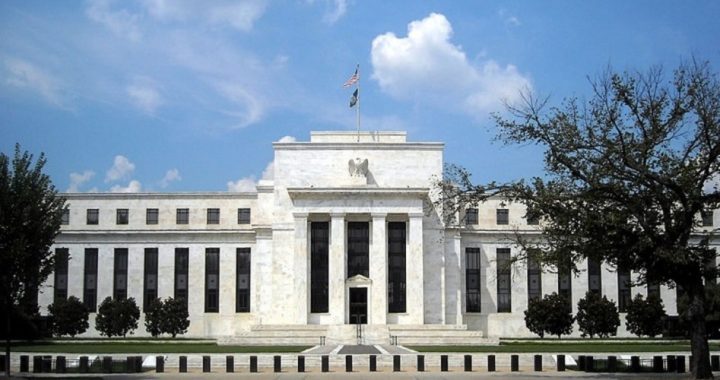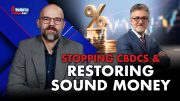
The announcement July 30 that the U.S. economy grew at a four-percent annual rate for the second quarter of 2014 has financial analysts wondering if the Federal Reserve Bank will end earlier than expected the “quantitative easing” and interest rate suppression it has engaged in since 2008.
According to the U.S. Bureau of Economic Analysis (BEA), “Real gross domestic product — the output of goods and services produced by labor and property located in the United States — increased at an annual rate of 4.0 percent in the second quarter of 2014…. In the first quarter, real GDP decreased 2.1 percent (revised).” The numbers for the first quarter were better than previously announced, as the revised estimate replaced a 2.9 percent decrease in GDP.
The BEA noted that much of the growth can be attributed to a change in business inventory rather than actual market sales:
The change in real private inventories added 1.66 percentage points to the second-quarter change in real GDP after subtracting 1.16 percentage points from the first-quarter change. Private businesses increased inventories $93.4 billion in the second quarter, following increases of $35.2 billion in the first quarter and $81.8 billion in the fourth quarter of 2013.
However, another part of the reason for economic “growth” was the increase in spending by the government sector, including state and local governments, with a 3.1-percent increase during the second quarter after several years of budget cuts.
The BEA also announced multi-year revisions to its economic growth projections, claiming that new analysis showed lower-than-announced growth had occurred in 2011 and 2012, but higher-than-announced growth had occurred in 2013. Reuters reported,
The government raised 2013 third-quarter growth to a 4.5 percent annual pace from the previous 4.1 percent. Growth for the fourth quarter of last year was lifted to a 3.5 percent annual rate from a previously reported 2.6 percent. Growth for 2013 was raised to 2.2 percent from 1.9 percent.
The lackluster recovery — an average of just over two percent real GDP growth since 2010, as compared to more than four percent annually for seven years after the 1981-82 recession — is largely a result of a much lower national savings rate (about half of the 1982 level), and to a lesser extent higher government debt load (more than double the 1982 levels). But with the economy apparently heating up a little, the Wall Street Journal reported July 30,
Debate at the Fed is now turning to when to start raising interest rates. When last surveyed in June, most Fed officials said they expected to wait until 2015 and to move gradually once rate increases begin.
Federal Reserve Bank Open Market Committee officials — who have suppressed interest rates to zero since 2007 and have been creating money that is given to banks under the label “quantitative easing” (QE) since 2008 — had previously announced they will create progressively lower quantities of money each month, but have yet to announce an end date to new money creation.
The purchase of banks’ financial assets (mortgages and student loans) on the open market by the Federal Reserve Bank with money created out of thin air is a direct transfer of wealth to the financial sector of the economy, in particular the largest banks and brokerage houses on Wall Street. Even at its current reduced rate of $35 billion per month (it once stood at $85 billion per month), QE is quite possibly the largest government corporate welfare scheme in human history.
For her part, Open Market Committee Chairman Janet Yellen has indicated that she doesn’t believe the economy will heat up to four-percent annual GDP growth. “The Committee expects that with appropriate policy accommodation,” Yellen said July 30 in a written statement on the Federal Reserve Bank’s website, “economic activity will expand at a moderate pace, with labor market indicators and inflation moving toward levels the Committee judges consistent with its dual mandate.”
That statement sounded to free market economists eerily like past economic prognostications of previous Fed chairmen. Yellen’s predecessor Ben Bernanke told the media as late as July 2007 that “Overall, the U.S. economy seems likely to expand at a moderate pace over the second half of 2007, with growth then strengthening a bit in 2008 to a rate close to the economy’s underlying trend.” Of course, by that time the “Great Recession” had already begun.
Many free market economists view the current economy as a bubble similar to the one of 2005-06, ready to pop once the Federal Reserve stops buying up mortgages and student loans in the open market under QE and lets interest rates rise.
EuroPacific Capital President Peter Schiff told Yahoo Finance July 30 that the high growth rate in the second quarter had to be balanced against the contraction in the first quarter:
The bad news is it’s all downhill from here…. I think that it’s obvious that the stimulus is wearing off, that the euphoric effects of all the cheap money — even though the cheap money is still here — the effects are wearing off.
Although Schiff added, “I think it’s clear that the economy is rolling over,” he did not believe that Federal Reserve officials would do the right thing and let market forces take over.
Establishment financial analysts are less certain, and there’s a fear of a new recession in an economy where the Federal Reserve cuts off of the economic “stimulus.” The London-based Financial Times warned July 30,
An outflow of deposits would be a reversal of a five-year trend that has seen significant amounts of extra cash poured into banks thanks to the Fed flooding the financial system with liquidity. These deposits, which act as a cheaper source of funding, have helped banks weather the aftermath of the financial crisis.
Now the worry is that such deposit funding may prove fleeting as the Fed retreats. Banks might have to pay higher rates on deposits to retain customers — potentially hitting their profits and sparking a price war for client funds.
The Federal Reserve’s policy of suppressing interest rates has had a devastating impact on U.S. national savings rates — the largest factor in sustainable economic growth — by punishing savers with interest rates that often don’t even equal the rate of inflation.
But despite “fears” of the corporate welfare gravy train ending on the part of Wall Street banking fat-cats, the Federal Reserve Bank has yet to announce a “tapering” of its $35-billion-per-month transfer of money from the purchasing power of consumers to big banks.
Photo of Federal Reserve Headquarters in Washington, D.C.



